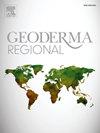地面森林采伐机械交通造成的影响:智利的最新状况和未来准则
IF 3.3
2区 农林科学
Q2 SOIL SCIENCE
引用次数: 0
摘要
据报道,木材采伐作业最常见的影响是对土壤的影响,主要集中在滑行道和其他交通繁忙的地区。针对地面采收机械影响的研究差异很大,主要由案例研究组成,这使得其难以应用于其他环境背景。考虑到智利森林部门的重要性、地点的多样性和该国的经营条件,以及主要存在通过滥伐作为短期轮作森林作物管理的种植园,查明智利的最新技术状况和知识差距至关重要。为此目的,通过系统地检索参考数据库中的文章,根据31个国家的252项研究确定了环境影响和有关的最佳管理做法建议。这些结果突出了世界范围内研究不足的地理区域和土壤类型。报告的干扰主要与土壤物理性质有关,其次是植物区系结构和组成、化学性质、水力学和土壤生物性质。确定并讨论了关于最佳管理做法的七项一般性建议。常见的建议包括减少土壤影响的预防措施。在智利进行的研究中,只发现了一篇索引文章(< 0.01%),这就提出了将搜索扩展到国家数据库的需要,在国家数据库中发现了另外五篇文章。本综述与国际研究结果一致。然而,人们认识到缺乏关于森林土壤、干扰类型和现代采伐机械对环境的影响的知识。此外,与滑道规划替代方案、土壤监测和恢复时间相关的研究存在空白。已经提出了与这些知识差距相关的研究需求。本文章由计算机程序翻译,如有差异,请以英文原文为准。
Impacts caused by the traffic of ground-based forest harvesting machinery: State of the art and future guidelines for Chile
The most frequently reported impacts of timber harvesting operations are on the soil and are mainly concentrated along skid trails and other areas of high traffic. Research addressing the impacts of ground-based harvesting machinery varies widely and is predominantly composed of case studies, which makes its application to other environmental contexts difficult. Considering the importance of the Chilean forest sector, the diversity of sites, and operational conditions in the country, as well as the predominant existence of plantations managed as short-rotation forest crops by clearcutting, it is paramount to identify the state of the art in Chile and knowledge gaps. To this end, environmental impacts and associated best management practice recommendations were identified based on 252 studies from 31 countries through a systematic search of articles in reference databases. The results highlight the under-studied geographical areas and soil types worldwide. The main disturbance reported were related to soil physical properties, followed by disturbance to the flora structure and composition, chemical properties, hydraulics, and soil biological properties. Seven general recommendations were identified and discussed regarding best management practices. Common recommendations include preventive measures to reduce soil impacts. In the case of studies conducted in Chile, only one indexed article (<0.01 %) was found, which raised the need to expand the search to national databases where five additional articles were found. This review is consistent with international study results. However, there is a recognized lack of knowledge regarding forest soils, types of disturbance, and the environmental impacts of modern harvesting machinery. Additionally, gaps in research related to skid trail planning alternatives, soil monitoring, and recovery times have been identified. Research needs related to these knowledge gaps have been proposed.
求助全文
通过发布文献求助,成功后即可免费获取论文全文。
去求助
来源期刊

Geoderma Regional
Agricultural and Biological Sciences-Soil Science
CiteScore
6.10
自引率
7.30%
发文量
122
审稿时长
76 days
期刊介绍:
Global issues require studies and solutions on national and regional levels. Geoderma Regional focuses on studies that increase understanding and advance our scientific knowledge of soils in all regions of the world. The journal embraces every aspect of soil science and welcomes reviews of regional progress.
 求助内容:
求助内容: 应助结果提醒方式:
应助结果提醒方式:


